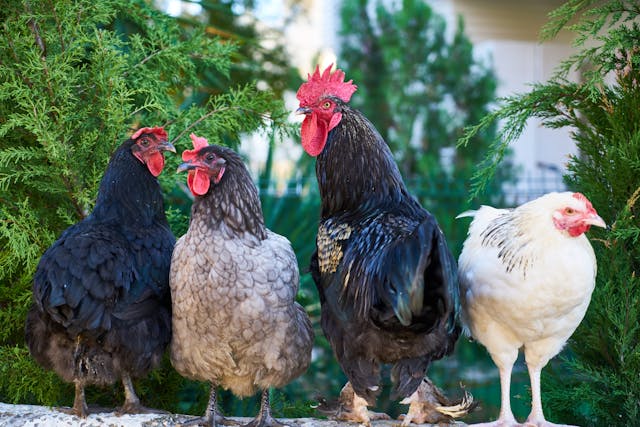Cannibalism in poultry, where birds peck and injure each other to the point of causing serious harm or even death, is a significant welfare issue that can lead to substantial economic losses. While various factors contribute to this behavior, including genetics, stocking density, and nutrition, light conditions are a critical yet often overlooked element. The type, intensity, duration, and color of light can all influence poultry behavior, potentially triggering or reducing cannibalistic tendencies. This article explores the relationship between different light conditions and cannibalism in poultry, offering insights into how farmers can optimize lighting to promote healthier, more harmonious flocks.
Understanding Cannibalism in Poultry
Cannibalism in poultry typically manifests as pecking at the feathers, skin, toes, or vent of other birds. This behavior can escalate rapidly, leading to injuries, stress, and even mortality within the flock. Cannibalism is often a symptom of underlying stress or frustration, and it can be triggered by factors such as:
- Overcrowding
- Poor ventilation
- Nutritional imbalances
- Inadequate environmental enrichment
- Inappropriate lighting conditions
Light plays a crucial role in regulating poultry behavior and physiology. It influences daily rhythms, feeding patterns, and social interactions. Therefore, manipulating light conditions offers a practical approach to managing cannibalism.
The Role of Light in Poultry Behavior
Light affects poultry behavior in several ways:
- Intensity: Bright light can increase activity levels and aggression, leading to more pecking and potential cannibalism. Conversely, too little light can result in lethargy and inadequate feeding.
- Duration: The length of light exposure (photoperiod) influences feeding and laying behaviors. Extended periods of light may increase aggression, especially in laying hens.
- Color (Spectrum): Different colors of light can affect poultry behavior and stress levels. For example, red light is often used to reduce aggression and cannibalism.
- Type of Light Source: The flicker rate of lighting, especially from older fluorescent bulbs, can stress birds and contribute to behavioral issues.
Effects of Different Light Conditions on Cannibalism
1. Light Intensity
- High Intensity: Studies have shown that high light intensity, typically above 20 lux, can lead to increased activity and aggression among poultry. This heightened state of arousal can trigger pecking and cannibalistic behaviors, particularly in densely populated flocks.
- Recommendation: To reduce cannibalism, maintain light intensity at moderate levels (10-15 lux) for most poultry types. In sensitive situations, such as with certain breeds prone to aggression, light levels as low as 5 lux may be beneficial.
- Low Intensity: While lower light intensity can reduce aggressive behavior, it is essential to balance it to avoid negative impacts on feeding and growth. Birds still need sufficient light to find food and engage in natural behaviors.
- Recommendation: Ensure that light intensity is sufficient for normal activity and feeding, typically not falling below 5 lux during active periods.
2. Photoperiod (Light Duration)
- Extended Light Exposure: Longer photoperiods can lead to increased feeding and laying activity but may also result in heightened aggression and stress, especially if birds are not provided with adequate rest periods.
- Recommendation: For layers, a photoperiod of 16-18 hours of light is standard. However, for broilers or birds showing signs of aggression, reducing the light period to 12-14 hours may help mitigate cannibalism.
- Shorter Photoperiods: Shorter days can reduce aggression but may also impact production. Balancing light exposure to ensure adequate rest without compromising growth or egg production is crucial.
- Recommendation: Adjust the photoperiod based on the specific needs of the flock and monitor for changes in behavior.
3. Light Color (Spectrum)
- Red Light: Red light has been shown to reduce cannibalism and aggressive pecking. This effect is likely due to the calming influence of red wavelengths, which can lower stress and aggression.
- Recommendation: Implement red lighting in areas where birds are most prone to aggression or cannibalism. Red light can be particularly effective in broiler houses and during periods of increased stress, such as during feather molting.
- Blue and Green Light: Blue and green lights are often used in poultry farming to promote growth and calm behavior. Blue light has been associated with reduced stress and aggression, while green light is known to enhance feed conversion efficiency.
- Recommendation: Use blue or green light to promote calmness and growth in young chicks and growing birds. Monitor the flock’s behavior to ensure these colors do not inadvertently reduce feeding or increase lethargy.
- White Light: Standard white light can be stimulating for poultry, sometimes leading to increased aggression if the intensity is too high.
- Recommendation: Use white light at lower intensities or mix it with other light colors to reduce potential triggers for cannibalism.
4. Type of Light Source
- LED vs. Fluorescent: LED lights are generally preferred over fluorescent bulbs in modern poultry farming due to their energy efficiency, reduced flicker, and ability to control the spectrum. Fluorescent lights, particularly older models, can cause flicker that stresses birds, potentially leading to behavioral issues like cannibalism.
- Recommendation: Use LED lighting systems to provide stable, flicker-free illumination. Adjust the spectrum and intensity to suit the specific needs of the flock.
Integrating Light Management with Other Cannibalism Control Strategies
While optimizing light conditions is essential, it should be part of a broader approach to managing cannibalism. Consider the following additional strategies:
- Environmental Enrichment: Providing perches, dust baths, and pecking objects can reduce boredom and redirect pecking behavior away from other birds.
- Balanced Nutrition: Ensure that birds receive a well-balanced diet that meets all their nutritional needs, particularly during stressful periods like molting or rapid growth.
- Stocking Density: Maintain appropriate stocking densities to minimize stress and competition for resources.
- Genetic Selection: Select breeds or lines known for lower aggression and better social behaviors.
Conclusion: Light as a Tool for Better Poultry Management
Light conditions play a crucial role in poultry behavior, particularly concerning cannibalism. By understanding how light intensity, duration, color, and type affect poultry, farmers can create environments that reduce the risk of aggressive behaviors. Implementing tailored lighting strategies, alongside other management practices, can significantly improve flock welfare, reduce injuries, and enhance productivity. As poultry farming continues to evolve, the careful consideration of lighting conditions will remain a key factor in promoting healthier, more harmonious flocks.


Leave a Reply